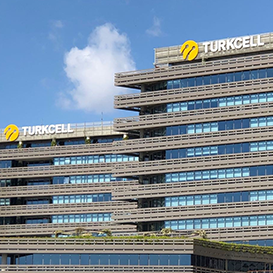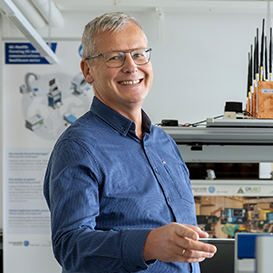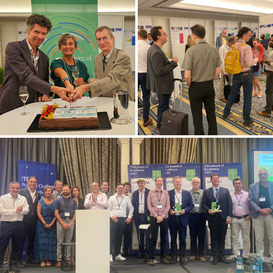COMPACT
Faster, more efficient software through automation

- Project
start
September 2017 - Project
end
December 2020 - Project
leader
Wolfgang Ecker
Infineon Technologies AG, Germany - More
information
https://itea4.org/project/compact.html
From industrial automation to healthcare, Internet of Things (IoT) has impacted every aspect of our lives. However, the cost pressure of making IoT devices as smart, cheap and energy efficient as possible affects both manufacturing and design costs, with software design accounting for around 45% of the overall System-on-Chip (SoC) development effort. Fast and efficient software development is thus a key enabler of future growth within the IoT domain.
Within the ITEA project COMPACT (Cost-Efficient Smart System Software Synthesis), 15 partners from Austria, Finland and Germany focused on enhancing IoT software by automating code generation from abstract models, thereby boosting productivity and reducing both manufacturing costs and performance issues. It also reduced embedded software costs in semiconductor-based products by selecting the best solution from multiple options based on system vision.
Automatic software generation based on models
COMPACT’s technology focused on tiny IoT devices, like those similar to Arduino. It mainly dealt with low-level software components such as drivers and hardware abstraction layers (HAL). The main goal was to make software for these small devices, where the hardware is limited in power and size because it has to be affordable. COMPACT sought to create a connection between how a device is modelled and how its software is developed. The solution is automatic software generation based on models, for which a complete chain of tools was developed.
Based on requirements, concepts and use cases from industrial partners, the project achieved major innovations in modelling, tooling & automation and analysis & optimisation. An IoT Platform Modelling Language (IoT-PML) defines the overall modelling approach and features various meta models for non-functional properties, specific functional behaviour and firmware configuration. This combines previously isolated modelling approaches and provides a foundation for the structuring and formalisation of the domain. For automatic code generation, various generators, libraries, plugins and tools for highly automated IoT software development were created and integrated into a framework. Static and dynamic methods can then analyse software properties (such as timing, power and memory footprint) and optimisation methods. Plugins enable software transformation to ensure that the generation overhead remains within an acceptable range.
Three demonstrators were also developed to illustrate the project’s relevance to multiple applications: smart sensors (model-based code generation workflow and virtual prototype-based software analysis), vehicle detection (use of IoT-PML in the Enterprise Architect tool) and an IoT sensor device (model creation and support for system architecture and functional interface refinement). As a contribution to standardisation, a COMPACT extension to the IP-XACT standard was finalised in Accellera and submitted to the Institute of Electrical and Electronics Engineers (IEEE). About 90% of the proposals have been included in the new standard.
Faster and more compact than human-written code
In terms of results, COMPACT exceeded expectations by generating highly efficient software, up to 90% of which is faster and more compact than human-written code. This results in less memory usage, less energy consumption and lower latency. Depending on the degree of generation, a 20-70% reduction in software development costs can be expected without any performance loss or memory footprint of the software code. As designers can produce around 2,000 lines of code per year and a person-year costs roughly EUR 150,000, COMPACT predicts that each line of generated code will have a value of 75 euros. Generators for a new device family therefore pay off with their first use.
As the project adopted an open software implementation for better dissemination, one of its key strengths has been broad exploitation by various channels. SME software tool companies have been able to create new tools while large semiconductor companies and system houses have created software more efficiently. This enables them to retain or expand their positions within the IoT for semiconductors market, expected to grow from USD 20 billion in 2017 (the start of COMPACT) to over USD 61 billion by 2024. SparxSystems Software GmbH, for instance, has built the base for cybersecurity modelling which is now part of the core product, enabling access to the aviation and space industry.
COMPACT exceeded expectations by generating highly efficient software, up to 90% of which is faster and more compact than human-written code.
In addition, cybersecurity modelling is available as a separate solution, including a form of automation named ThreatGet (www.threatget.eu). This is an award-winning product: Report eAward (1st place), Constantius Award (1st place in the category of IoT) and a nomination for the State Award for IT Consultancy. Targeted customer domains include automotive, industry, critical infrastructure, space and more. SparxSystems Software GmbH has increased its workforce by five employees and two trainees and is in the process of strategically taking over another company in the IoT domain. Revenues have increased by 15% in this domain. Further strategic investments in the direction of model transformation down to Model2Code have resulted in additional research projects (Eureka Penta project ECOMAI and ITEA project GenerIoT). SparxSystems Software GmbH aims to provide a compilable, debuggable open-source Model2Code implementation for RUST (based on the MIT License) as this seems to be the next big thing in the embedded domain.
Similarly, Kasper & Oswald GmbH has presented its new COMPACT Crypto API (CCAPI) to several customers in the automotive and home automation domains and used parts of this in internal product development. Kasper & Oswald GmbH has trained two junior engineers to further extend platform support, one of whom is now moving to a full-time role in the company. The results of COMPACT also feed into two follow-up projects, DevToSCA and FreeSBee, both funded by the German BMBF.
Finally, Visy Oy’s demonstrator of a vehicle model classifier and license plate recogniser is in use at four customer sites and they expect orders worth EUR 1.8 million for systems with technologies developed in COMPACT. The vehicle model recognition also led to vehicle colour recognition and is currently operational at 20+ customer checkpoints. More importantly, the newly developed computational technologies are an essential part of Visy Oy’s offering to all customer sites, enabling more efficient edge computing.
The ITEA project GenerIoT and the PENTA project ECOMAI serve as vivid examples that use the research outcomes of COMPACT.
IoT to benefit our daily lives
As for the future, the project showed that automated model-based code generation works efficiently, which will encourage work to bring model-based code generation to the next abstraction levels, such as runtime systems and applications focused on digital signal processing (DSP). COMPACT also demonstrated the power of using AI for software optimisation in combination with code generation and compiler configuration.
The COMPACT project significantly benefits society by automating IoT software development, thereby reducing costs by 20-70%, enhancing energy efficiency, improving security and fostering industry growth. Its contributions to standardisation and technological advancements strengthen the IoT sector, opening new markets and research opportunities, in turn opening up new uses for IoT to benefit our daily lives.

Other chapters
Use the arrows to view more chapters

Editorial
By Jean-François Lavignon

25 years of ITEA
The ITEA journey

Country Focus: Türkiye
Investing in ICT to enhance competitiveness and international profile

Turkcell
Becoming a deeper part of the ecosystem

Community Talk with Frank Golatowski
A long-lasting happiness

ITEA Success story: TESTOMAT Project
Customised test automation, saving time and improving quality

25 years of ITEA
Ground-breaking innovations we’re still grateful for today

SME in the Spotlight: Solana Networks
Looking to the horizon of network security

ITEA Success story: COMPACT
Faster, more efficient software through automation

Navigating the future of ITEA
Current challenges and future directions

By and for end users
Gränges further digitalises aluminium engineering with the help of VMAP analytics

25 years of ITEA: PO Days through time
Celebrating 25 years of international collaboration

